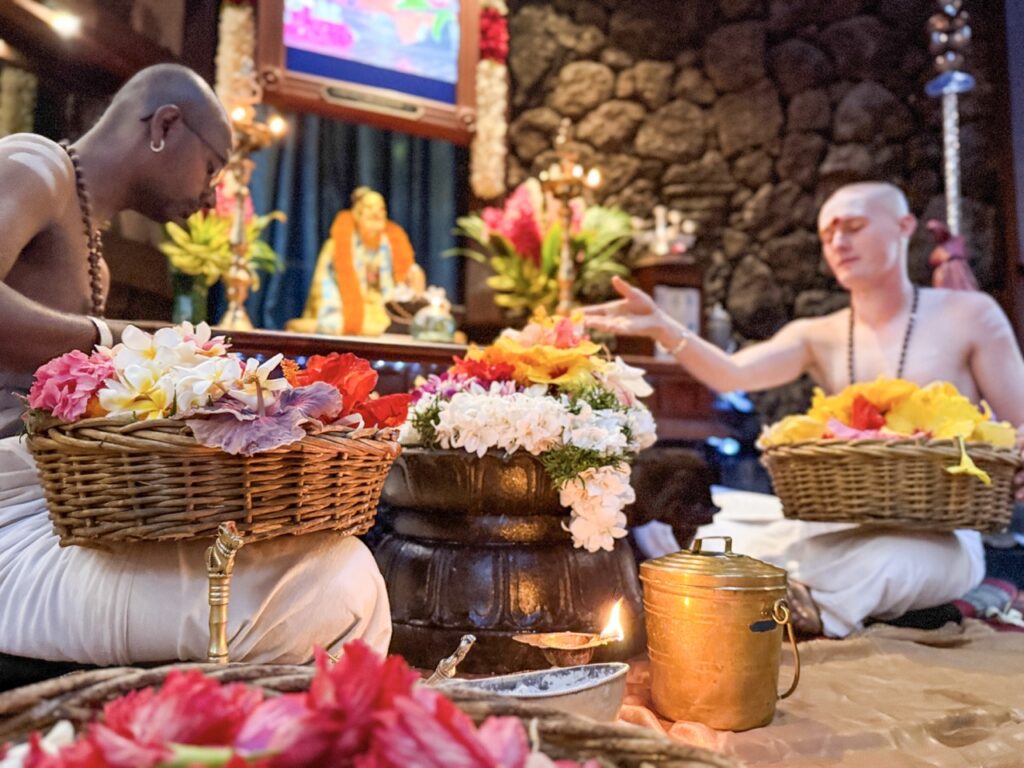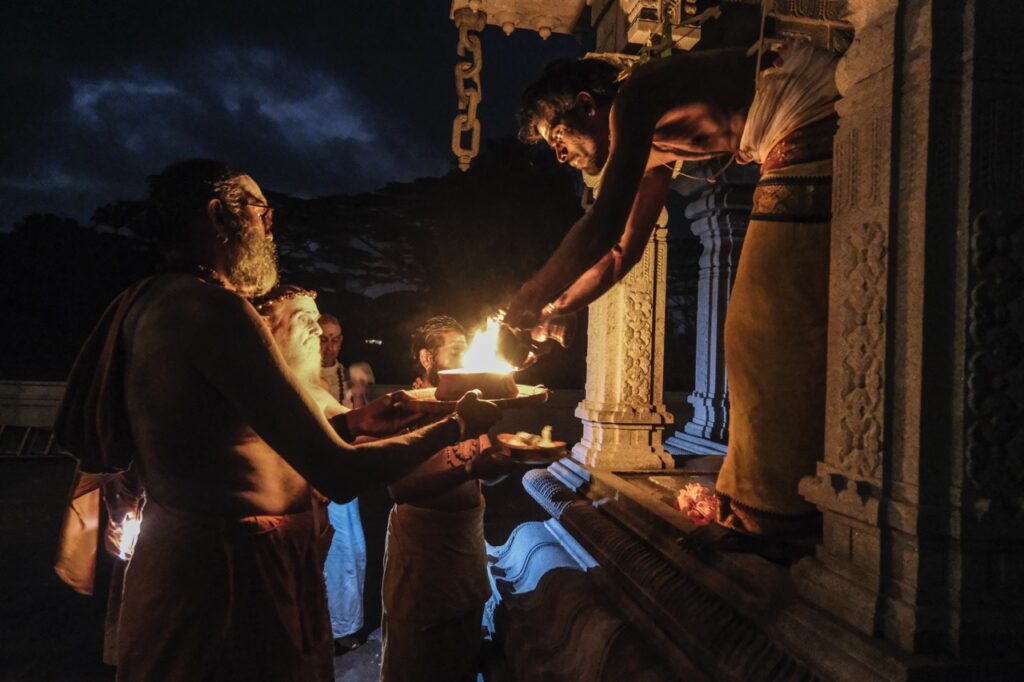Nestled amid the lush greenery of Kauai, far from the pace of modern life, stands a sanctuary of silence and sacred service—Kauai’s Hindu Monastery, international headquarters of the Saiva Siddhanta Church. Established in 1970 by Satguru Sivaya Subramuniyaswami, known affectionately as Gurudeva, the monastery is home to a small order of monks who have dedicated their lives wholly to God, Gods, and guru. Here, eighteen monastics live as one spiritual family, following a rhythm of meditation, worship, study, and service that continues the ancient Saivite monastic tradition of South India and Sri Lanka.

Our Order and Mission
Saiva Siddhanta Church is a nonprofit religious organization serving the global Hindu community—its members and students living in nations around the world. Its mission, set forth in the Saiva Dharma Shastras, is “to protect, preserve and promote the Saivite Hindu religion, to foster the growth of all sects of Hinduism through Hindu solidarity and to teach monistic Saiva Siddhanta for the spiritual unfoldment of the individual and the family through temple worship and daily sadhana.”
From the monastery’s 382-acre tropical property, the monks oversee a vast network of educational, religious, and cultural activities—publishing Hinduism Today magazine, maintaining multiple websites, guiding members, conducting temple rituals, and serving pilgrims who come for solace and inspiration. Two temples stand at the heart of the monastery: Kadavul Temple, established in 1973, and Iraivan Temple, a hand-carved white granite masterpiece consecrated in 2023. Together they form a living center of Saivism and a place of pilgrimage for thousands each year.
The Daily Rhythm of Monastic Life
The monks rise long before dawn. At 4:00 a.m. they bathe and enter into silence. Each performs private japa and meditation in his hut before gathering at 5:30 for the early-morning puja in Kadavul Temple. There, flames of camphor flicker in the dark and bells ring through the halls as Sanskrit mantras and offerings are made to Lord Siva.
Following worship comes a full hour of group meditation, led by the abbot, Satguru Bodhinatha Veylanswami. Gurudeva described meditation as the very core of monastic striving, explaining that “this great realization occurring time and time again within someone day after day keeps the door of Brahm open for the entire prana chakravala of monastics.” Through this daily practice, the monks strengthen their inner communion with the divine and with their spiritual lineage.

The morning hours are devoted to disciplined service within one of five monastic departments, called kulams—a Tamil word meaning “family group.” Each kulam focuses on a particular sphere of responsibility: temple worship, teaching, publications, construction, or finance. Every monk serves within one kulam, yet all cooperate closely, embodying the ideal that “work is worship.” As Gurudeva taught, “Performing our work with the aim of reaching God naturally leads to the perspective that each task is an offering to the Lord. Every act, from the grandest to the lowliest, becomes a sacred rite.”
The monastery’s day flows in harmony from dawn to night: sacred service in the morning, meditation or study in the afternoon, and quiet reflection by sunset. At 9:00 p.m., the lights go out, and stillness once again fills the cloister.
Worship and Meditation
Temple worship, or puja, is the heartbeat of the monastery. Every day, offerings of lamps, flowers, and mantras are made in the two temples. The monks celebrate major festivals such as Ganesha Chaturthi, Skanda Shashti, Maha Ardra, and Krittika Dipam, drawing together pilgrims and island devotees in an atmosphere of joy and devotion.

Equally vital is the inner worship of meditation. The monks practice a mystical language of meditation called Shum, revealed by Gurudeva as a precise map of inner consciousness. Their ultimate goal is Self Realization—the direct experience of the Divine within. “It is the lifelong ambition of every monk to realize the Self and then realize it again, and again,” Gurudeva wrote. Through their collective meditation, he explained, “the inner actinic connection with all gurus of our parampara… keeps vibrantly strong the monastery’s inner life.”
Training and Vows
To enter the monastic order, a man must choose what Hinduism calls one of its two adult paths: the householder or the renunciate. As Satguru Bodhinatha Veylanswami, the monastery’s current abbot, writes in Path to Siva, “Most people follow the family path. A rare few follow the monastic path. Instead of having a spouse and children, they embrace the whole world as their family. They have two goals: to serve humanity and realize God.”

Those who choose the renunciate path begin as aspirants, living for several years under vows of purity and service before taking formal lifelong commitments. Monastic life is celibate, communal, and austere. The monks wear unstitched white cotton robes, their heads shaved as a sign of renunciation. Their needs—food, clothing, shelter, and medical care—are provided by the Church, allowing them to live free from personal possessions and concerns.
Community and Service
While much of monastic life is inwardly focused, the monastery’s influence reaches far beyond its forested gates. The monks edit and publish Hinduism Today, conduct global webinars and courses, host pilgrims, and guide families through correspondence. Visitors describe the monastery as “a greenhouse for spiritual unfoldment,” a place where peace, discipline, and kindness permeate every activity.
Living Simply
The monks live simply but comfortably. Each has a small room for rest and meditation, access to shared gardens, a vegetarian diet, and communal recreation and exercise areas. They receive no personal income, yet their needs are abundantly met through the Church’s monastic endowment and the tithing of devotees. “Even though we live simply,” one senior monk explains, “we want for nothing.”
The Spirit of Renunciation
At the core of this sacred way of life is renunciation, a conscious turning away from personal gain toward selfless service. Gurudeva wrote that the monastic’s ideal is “to worship God by serving all beings as His living manifestations and tending to His creation as the body of God.”

Each monk strives to perform his daily work—whether building a temple wall, editing a book, or tending the gardens—as an act of devotion. In Sanskrit this attitude is called Ishvara arpana buddhi, “offering all action to God.” Over time, such discipline purifies the heart and leads to a steady peace known as summa iru, “simply be.”
A bronze plaque affixed to the Iraivan Temple expresses this spirit:
“You are standing in the heart of Kauai’s Hindu Monastery, which covers many acres of gardens, groves, glens, paths, ponds and waterways. Also called Kauai Aadheenam, this monastery-temple complex is the secluded, cloistered home and theological seminary for dedicated monks who live and serve here full time, pursuing the dual goals of selfless service and self-transformation through the yogas of devotion and meditation.”
